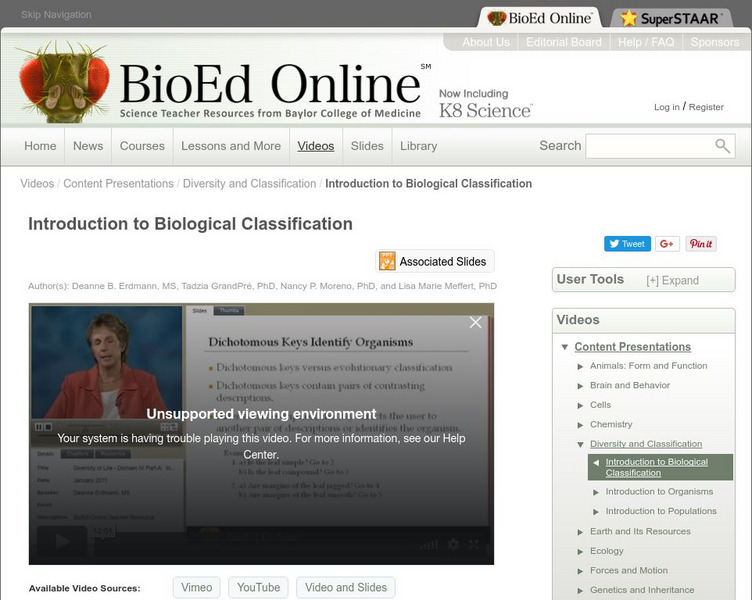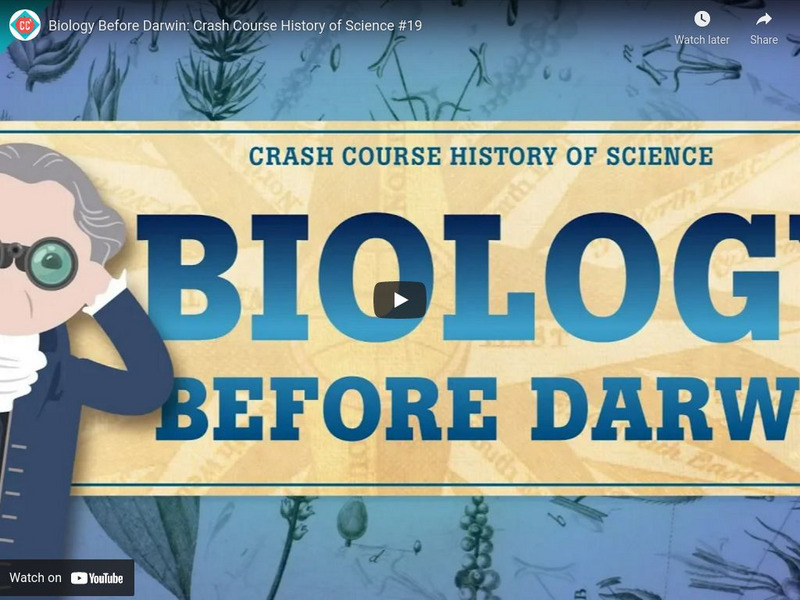Massachusetts Institute of Technology
Mit: Blossoms: Classifying Animals by Appearance Versus Dna Sequence
The topic of this video module is how to classify animals based on how closely related they are. The main learning objective is that students will learn how to make phylogenetic trees based on both physical characteristics and on DNA...
Massachusetts Institute of Technology
Mit: Blossoms: How Much Small Is Small?
This video lesson introduces students to the concept of size. It looks at how to classify objects based on their size and how the size of an object affects its properties and behavior. In our world, we have many different sizes -...
BioEd Online
Bio Ed Online: Introduction to Biological Classification
In the following video you will learn how classification is a continually evolving scientific effort to group organisms based on knowledge gathered from different fields. You will also learn how it helps to define the relationships among...
Khan Academy
Khan Academy: Taxonomy and the Tree of Life
Dicover the science of taxonomy and where humans fit into the tree of life. [12:41]
Sophia Learning
Sophia: Classification Papers
This video tutorial focuses on a type of informative writing called classification papers. It defines classification writing, provides an organization pattern for the material, and offers a general outline for classification papers.
PBS
Pbs Learning Media: Is It Alive?
What is it that distinguishes a living organism from a nonliving object? This video presents examples that aren't as clear-cut as one might think, enticing students to question what it means to be alive. [3:02]
Khan Academy
Khan Academy: Cousin Fal's Shape Collection
Sal helps his cousin classify shapes based on their number of sides, number of corners, and side-lengths. Includes a video, transcript, and question and answer section. [4:18]
Crash Course
Crash Course Kids 1.2: Feed Me: Classifying Organisms
FEED ME! In this episode of Crash Course Kids, Sabrina has a chat with us about what living things eat to get energy. What makes something an omnivore, or a carnivore, or an herbivore? And just exactly how do plants fit in to all of...
Crash Course
Crash Course Biology #19: Taxonomy: Life's Filing System
Hank tells us the background story and explains the importance of the science of classifying living things, also known as taxonomy. [12:15]
Crash Course
Crash Course Kids 35.1: Organizing Properties
Just like groups of people have major things in common, so do different materials. So how does that work? How can we group materials by their properties? Find out by watching this video. [4:31]
Sophia Learning
Sophia: Classification of Matter
This lesson will introduce the systematic classification of matter used in chemistry, defining the terms heterogeneous, homogeneous, pure substance, mixture, compound, element and providing examples.
Crash Course
Crash Course History of Science #19: Biology Before Darwin
You've probably heard of Charles Darwin, but how did scientists before him form their theories about life, evolution, and extinction? Learn how different people in the seventeenth and eighteenth century tried to answer the question -...
Khan Academy
Khan Academy: Species
Sal Khan explains the definition of a species and looks at some hybrid species such as ligers and tiglons. [8:48]
Khan Academy
Khan Academy: Species
Hear about what a species is and is not, and discuss ligers, tiglons, mule, hinnies, and dogs. [8:49]
Khan Academy
Khan Academy: Taxonomy and the Tree of Life
This video explores the science of taxonomy and where humans fit into the tree of life. [12:41]
Next Vista for Learning
Next Vista for Learning: Identifying Birds
A short video giving step-by-step instructions on how to identify birds in nature. Video also explores how to use a field guide to help with identification as well as an online resource. [2:28]
Sophia Learning
Sophia: The Study of Matter: Classification, Structure, Properties and Changes
This lesson will introduce chemistry as the science that studies matter: its classification, structure, properties and changes.

















